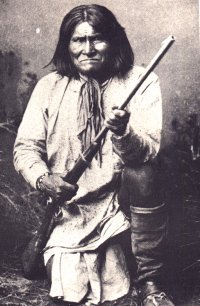

Geronimo, or Goyathlay (one who yawns) was born in 1829 in what is today western New Mexico. He was a Bedonkohe Apache by birth. He was reportedly given the name Geronimo by Mexican soldiers, although few agree as to why. As leader of the Apaches at Arispe in Sonora, he performed such daring feats that the Mexicans singled him out with the name "Geronimo." Some have attributed his numerous raiding successes to powers conferred by supernatural beings, including a reputed invulnerability to bullets.
Geronimo's war career was linked with that of his brother-in-law, Juh (a Chiricahua chief). Although he was not a hereditary leader, Geronimo appeared so to outsiders because he often acted as spokesman for Juh, who had a speech impediment.
Geronimo was the leader of the last American Indian fighting force to formally surrender to the United States. Because he fought against such great odds and held out the longest, he became the most famous Apache of all. To the pioneers and settlers of Arizona and New Mexico, he was a bloody murderer, and this image endured until the second half of this century.
To the Apache's, Geronimo embodied the very essence of the Apache values: aggressiveness, and courage in the face of difficulty.
The Chiricahuas were mostly migratory following the seasons, hunting, and farming. When food was scarce, it was the custom to raid neighboring tribes. Raids and vengeance were an honorable way of life among the tribes of this region.
When the Chiricahua were forcibly removed (1876) to arid land at San Carlos in eastern Arizona, Geronimo fled with a band of followers into Mexico. He was soon arrested and returned to the new reservation. For the remainder of the 1870's, he and Juh led a quiet life on the reservation. But with the slaying of an Apache prophet in 1881, they returned to full-time activities from a secret camp in the Sierra Madre Mountains.
In 1875, all Apaches west of the Rio Grande were ordered to the San Carlos Reservation. Geronimo escaped from the reservation three times and although he surrendered, he always managed to avoid capture. In 1876, the US Army tried to move the Chiricahuas onto a reservation, but Geronimo fled to Mexico eluding the troops for over a decade. Sensationalized press reports exaggerated Geronimo's activities, making him the most feared and infamous Apache. The last few months of the campaign required over 5,000 soldiers, on-quarter of the entire Army, and 500 scouts, and about 3,000 Mexican soldiers to track down Geronimo and his band
In May 1882, Apache scouts working for the US Army surprised Geronimo in his mountain sanctuary, and he agreed to return with his people to the reservation. After a year of farming, the sudden arrest and imprisonment of the Apache warrior Ka-ya-ten-nae, together with rumors of impending trials and hangings, prompted Geronimo to flee on May 17, 1885, with 35 warriors, and 109 women, children, and youths. In January 1886, Apache scouts penetrated Juh's impregnable hideout. This action forced Geronimo to surrender to General George Crook. Geronimo later fled, but finally surrendered to General Nelson Miles on September 4, 1886. The government breached its agreement and transported Geronimo and nearly 450 Apache men, women, and children to Florida for confinement in Forts Marion and Pickens. In 1894, they were removed to Fort Sill in Oklahoma. Geronimo became a rancher, appeared at the Louisiana Purchase Exposition in St. Louis (1904), sold souvenirs, and rode in President Theodore Roosevelt's 1905 inaugural parade.
Geronimo died on February 17, 1909, a prisoner of war, unable to return to his homeland. He was buried in the Apache cemetery at Fort Sill, Oklahoma.
